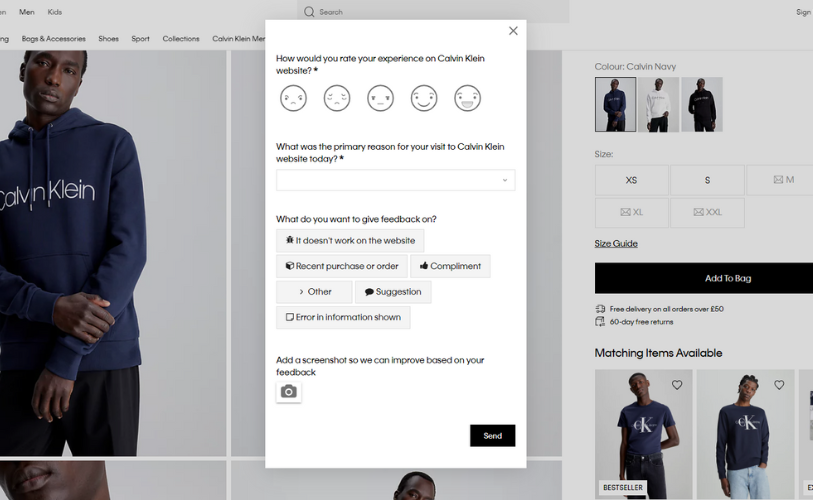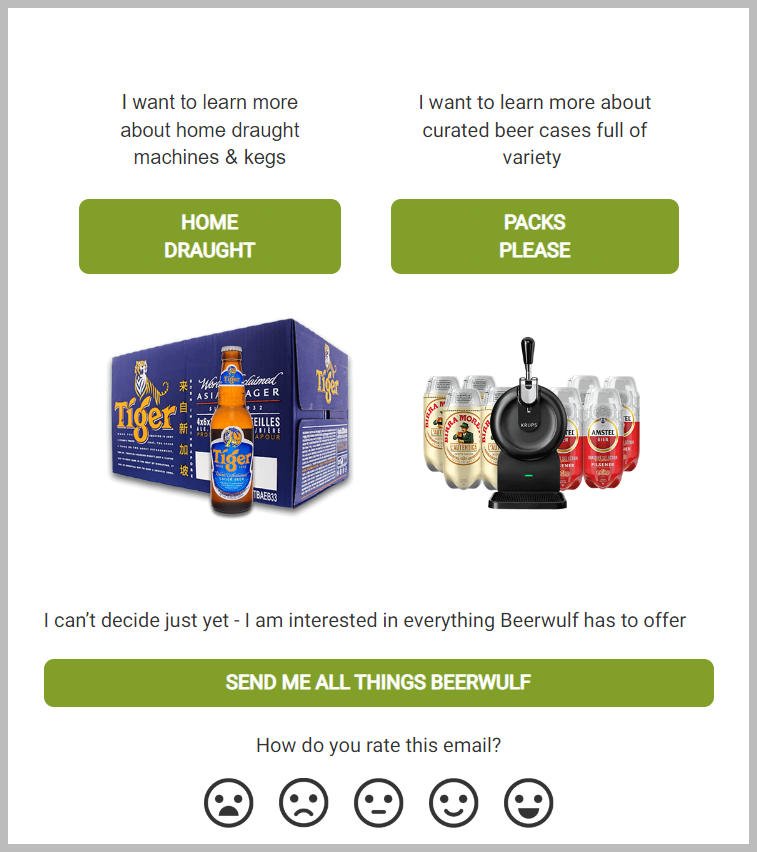Listening to the Voice of Customer (VoC) is a process that helps your organisation map out the wishes and needs of your customers, enabling you to create an optimal customer experience. What’s interesting about this process, however, is that every organisation gathers and utilises this data differently.
Are you in need of some inspiration for your VoC program? Then let’s take a look at some great, real-life voice of customer examples.
First things first: As we at Mopinion specialise in digital feedback for websites, mobile apps and email, we naturally have a lot of knowledge and expertise on this specific subject. Because of this, we have chosen to focus specifically on digital VoC examples.
So without further ado, in this post, we’ll show you how the following top-tier organisations gather VoC data digitally:
Voice of Customer examples from top brands
Let’s dive in!
1. Calvin Klein
Calvin Klein places a lot of emphasis on data driven decision making, hence their need to validate ideas before implementing them on their digital channels. They do so by gathering Voice of Customer data with Mopinion’s feedback software. This data helps them understand WHY visitors do what they do.
The team has strategically deployed multiple surveys across the website.

Example of a Calvin Klein CSAT Survey triggered from the feedback button (see right)
Which surveys do they use?
Calvin Klein permanently features a default feedback button across the website, as well as a permanent survey on the Payment page checking for payment problems (after a set of rules has been met). They also have a survey on the Confirmation page, asking their visitors to recall their shopping experience.”
Excerpt from Calvin Klein’s customer testimonial:
Davy Schuyt, CRO Manager at Calvin Klein:
The shorter a survey, the more chance someone fills it in. The longer the survey, the more information we get. Generally, we keep the questions to a max of 3, but we always include a field for open input. It’s important that we can categorise the answers, but more important that people don’t feel like they have to change their opinion to fit a predetermined answer.
“As per the activation, we go through our qualitative data sources to ascertain at what point a visitor is most likely to run into an issue that we are trying to solve. That can be on a certain page landing, but also after a certain time, or a certain action taken. That is when we will launch the survey.”
2. Allianz
Allianz, on the other hand, uses Voice of Customer data in a slightly different manner. The organisation – active in the insurance and financial services industry – collects customer feedback primarily to discover obstacles within the customer journey.
According to one of their Conversion Specialists Stefan van Ballegooie, the great advantage of collecting customer feedback is that you can identify problems that you had not yet discovered yourself.
Which surveys do they use?
Allianz currently uses passive and active feedback on the website. Passive feedback is collected by a button on the website. The visitors let the team at Allianz know what they think of the website.

Example of an Allianz general feedback survey (in Dutch only)
To prevent drop offs in conversion, Allianz also collects active feedback via an exit survey. An exit survey is a short questionnaire which asks visitors to share why they are leaving the site or page. Often this feedback form appears just before someone ‘threatens’ to leave the page and moves the mouse towards the exit, or if someone is on a page for a certain amount of time.

Example of an Allianz exit survey (triggered when leaving the page)
In the example above, Allianz specifically asks if the visitor found what they were looking for. This is a great way of learning whether the information they have on the website is helpful for the visitor.
Learn more about how Allianz boosts conversions with feedback here.
3. Beerwulf
The online beer retailer, Beerwulf, is another excellent example of a brand that uses VoC data in an effective way.
Beerwulf uses feedback surveys (via Mopinion) to collect Net Promoter Score (NPS), as well as for specifically targeting surveys and polls. The latter is done for two reasons:
- Monitoring obstacles or drop-off points where Beerwulf is aware there is an issue, but cannot determine exactly what the issue is or what the best solution might be.
- Exploring interest in new pages, functionalities and products.
They also have a great voice of customer example of how you can improve your marketing emails by asking for feedback.

Learn more about how Beerwulf uses feedback.
4. SUPER RTL
TOGGO – a brand by Germany’s leading kids’ entertainment provider SUPER RTL uses Mopinion in a wide variety of ways. This is because there are multiple teams within the organisation that are interested in these different feedback insights, including the Insights- , Product-, Marketing- and Sales teams.
Our aim with feedback is to gain insights into various facets of the website and app.
At the moment TOGGO has the following VoC surveys running on the website and in-app: General Happiness Forms, Feature-related surveys, Fake door testing surveys and market research forms.
Example of the General Happiness form on the website:

Example of one of the fake door testing surveys:

Check this story to learn more about how TOGGO monitors the voice of customer.
5. DHL
Global logistics and courier service DHL is another great example of how to use voice of customer surveys effectively. The organisation utilises surveys primarily for email but also deploys surveys in-app for general feedback inquiries.

Example of DHL’s in-app feedback survey.
The email surveys help the team measure customer service performance and customer satisfaction around delivery.

Example of delivery service feedback survey.
6. Maxi Cosi
Here’s another example from Maxi Cosi (a Dorel Juvenile company). This survey is triggered proactively after 120 seconds on the website. But excludes the check-out, contact-us, support, cart and some other pages. It also doesn’t show up if you have already answered another feedback form.

VoC survey triggering is an important part of obtaining relevant VoC insights. As you can see with this example, you can choose from different ‘rules’ that trigger the form, including: time on page, mouse movement, cookies, URL parameters, etc.
7. Etos
Etos, an Ahold Delhaize company, also gathers voice of customer data. One great example of how this brand does is via conversational feedback. Conversational feedback is a relatively new-to-market feedback solution which gives your feedback surveys a chat-like feel and a more personalised experience.

How does it work?
By applying logic to your surveys, you can create the feeling of a real two-way conversation. Logic is then mapped out for you in an easy-to-understand table. Visualise the routes your survey will follow, zoom in or out, or drag the various question routes in order to make it as clear as you need it to be.
A nice bonus is that these types of surveys actually increase your response rates compared to static feedback forms.
Key takeaways
So what can these Mopinion brands teach us about gathering voice of customer data?
They show us that there are a wide variety of ways to gather input from our customers, both by using passive feedback forms (e.g. a static feedback button) as well as active feedback forms (triggered by the visitor). They also show us how much one voice of customer program can differ from the next – depending on the goals an organisation has set out for themselves. For example, as you can see above Allianz is an organisation that uses VoC data heavily for conversion optimisation, whereas a brand like SUPER RTL focuses on market research, product backlog insights and customer satisfaction.
That being said, it’s important to evaluate which goals you want to achieve with your VoC data prior to starting your voice of customer program. Do you want to better understand how a visitor experiences a certain funnel on your website, improve your email campaigns or feed your backlog with useful feature insights?
Once you’ve nailed that down, then you can start creating VoC surveys for each of these goals, determine which channels (e.g. web, email, or mobile app) you want to deploy them on and how you want them to be triggered for your visitors.
Need more inspiration? Be sure to check out our Surveys 101 guide.
Ready to see Mopinion in action?
Want to learn more about Mopinion’s all-in-1 user feedback platform? Don’t be shy and take our software for a spin! Do you prefer it a bit more personal? Just book a demo. One of our feedback pro’s will guide you through the software and answer any questions you may have.






